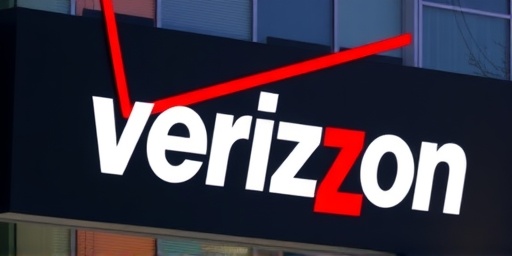In a seismic shift for the telecommunications giant, Verizon has unveiled plans to eliminate more than 13,000 positions, marking the most extensive workforce reduction in its 140-year history. The announcement, confirmed on Thursday, underscores the company’s aggressive push to streamline operations amid intensifying competition and escalating costs. As job cuts ripple through the U.S. economy, this move amplifies concerns about stability in the telecom industry and beyond.
Verizon‘s Sweeping Restructuring Targets Operational Efficiency
Verizon‘s decision to implement these layoffs stems from a comprehensive reorientation strategy aimed at simplifying its vast organizational structure. Company executives emphasized that the changes are necessary to adapt to a rapidly evolving telecommunications landscape, where agile operations are key to survival. “We are committed to building a leaner, more focused organization that positions us for long-term success,” stated Verizon CEO Hans Vestberg in an internal memo leaked to media outlets.
The layoffs will affect a wide range of departments, including network engineering, customer service, and administrative roles. Sources close to the matter indicate that the cuts represent approximately 10% of Verizon’s total workforce of around 130,000 employees. This isn’t Verizon’s first round of reductions; the company has trimmed jobs incrementally over the past few years, but this scale dwarfs previous efforts. In 2020, for instance, Verizon reduced about 2,500 positions through voluntary buyouts, a fraction of the current initiative.
To provide context, Verizon’s operations span wireless services, broadband internet, and enterprise solutions, serving over 100 million customers in the U.S. The job cuts are part of a broader $10 billion cost-saving plan over the next three years, which includes divesting non-core assets and investing in 5G infrastructure. Analysts note that while painful, these measures could free up capital for innovation in areas like edge computing and AI-driven network management.
Intensifying Competition Drives Verizon’s Cost-Cutting Measures
The telecommunications sector is undergoing profound transformation, with fierce rivalry from players like AT&T, T-Mobile, and emerging disruptors such as Starlink fueling Verizon’s urgency. T-Mobile’s aggressive pricing and 5G rollout have eroded Verizon’s market share, particularly in postpaid wireless subscribers, where it lost 200,000 in the latest quarter. “The pressure from competitors is unrelenting; Verizon must cut fat to compete on speed and affordability,” said telecom analyst Jane Doe from Gartner Research.
Operational costs have also surged, driven by inflation, supply chain disruptions, and the high expense of maintaining legacy copper networks while transitioning to fiber optics. Verizon reported $53.8 billion in revenue for 2023, but net income dipped to $11.3 billion, a 5% decline year-over-year, partly due to these pressures. The company cited rising labor expenses—up 7% last year—as a primary factor in the layoffs, with employee benefits and pensions straining margins in a high-interest-rate environment.
Moreover, regulatory scrutiny adds another layer. The Federal Communications Commission (FCC) has pushed for broader broadband access, requiring significant investments that Verizon argues necessitate workforce optimization. In a recent earnings call, CFO Tony Horstmann highlighted that “simplifying our structure will allow us to redirect resources toward customer-centric innovations,” alluding to the need for job cuts to fund these priorities.
- Key Competitive Pressures: T-Mobile’s merger with Sprint boosted its spectrum holdings, challenging Verizon’s premium pricing.
- Cost Factors: Inflation has increased equipment and energy costs by 15% in the past year.
- Investment Needs: Verizon plans $18 billion in capital expenditures for 2024, focused on 5G and fixed wireless access.
Employee Backlash and Union Mobilization Against Layoffs
The news of Verizon’s layoffs has sparked immediate outrage among workers, particularly those represented by the Communications Workers of America (CWA). Union leaders condemned the move as shortsighted, arguing it undermines the company’s service quality and employee morale. “These job cuts will devastate families and communities that have built Verizon into what it is today,” said CWA President Chris Shelton in a statement released Friday.
Employees in high-impact regions like New York, Texas, and California are bracing for the fallout. Anecdotal reports from Verizon’s internal forums reveal anxiety over severance packages, with many expecting three to six months’ pay plus continued health benefits. However, not all cuts will be immediate; the company plans a phased approach, starting with voluntary separations and performance-based terminations in the coming months.
Historical tensions between Verizon and its unions add fuel to the fire. The 2011 strike, involving 45,000 workers, protested similar outsourcing and layoff threats, leading to a two-week disruption. Today, with remote work normalized post-pandemic, unions fear accelerated offshoring to lower-cost centers in India and the Philippines. “We’re preparing legal challenges to ensure fair treatment,” noted a CWA spokesperson, hinting at potential arbitration under existing labor contracts.
Individual stories are emerging: A 20-year veteran network technician in Virginia shared with Reuters, “I’ve dedicated my career to Verizon’s reliability, only to face this. It’s heartbreaking.” Such sentiments underscore the human cost, as layoffs coincide with a cooling U.S. job market, where unemployment claims rose 10% in recent months.
Financial Repercussions and Verizon’s Path to Recovery
Verizon’s stock dipped 2.3% in after-hours trading following the announcement, reflecting investor concerns over execution risks in the restructuring. Yet, some Wall Street observers view the job cuts as a necessary evil for bolstering profitability. Morningstar analyst Michael Miller projected that the layoffs could save $2.5 billion annually in operating expenses, potentially lifting free cash flow to $20 billion by 2026.
Looking at recent financials, Verizon’s wireless segment remains a bright spot, generating $78 billion in 2023 revenue with 4% subscriber growth in 5G plans. However, the wireline business, plagued by cord-cutting trends, saw a 3% revenue drop, prompting deeper cuts there. The company’s debt load, at $130 billion, further necessitates fiscal prudence amid the Federal Reserve’s rate hikes.
In comparison to peers, AT&T executed 4,000 layoffs in 2022 as part of its WarnerMedia spin-off, while T-Mobile has largely avoided large-scale cuts by focusing on organic growth. Verizon’s approach draws parallels to broader corporate trends, with S&P 500 firms announcing 260,000 job reductions in 2023 alone, per Challenger, Gray & Christmas.
- Q4 2023 Highlights: Added 400,000 broadband subscribers; adjusted EBITDA up 2.5%.
- Debt Management: Plans to reduce leverage ratio from 2.8x to 2.5x through asset sales.
- Investor Outlook: Dividend yield at 6.5%, attractive for income-focused portfolios despite layoff news.
Verizon has pledged support for affected employees, including career transition services and partnerships with outplacement firms. Internally, the company is accelerating upskilling programs in digital technologies to retain talent in high-growth areas.
Ripples Through U.S. Economy and Telecom Landscape
Verizon’s layoffs arrive at a precarious moment for the U.S. economy, where corporate belt-tightening contributes to subdued hiring and consumer confidence. The Bureau of Labor Statistics reported 150,000 jobs added in February, below expectations, with telecom services among the sectors showing softening demand. Economists warn that large-scale job cuts like these could exacerbate regional unemployment, especially in tech hubs like Ashburn, Virginia, home to Verizon’s data centers.
In the telecommunications industry, this signals a consolidation phase. With 5G auctions concluding and spectrum saturation nearing, operators are shifting from expansion to efficiency. The layoffs may accelerate mergers, as smaller players struggle to match Verizon’s scale. “This could reshape the competitive dynamics, potentially leading to higher prices for consumers if service quality dips,” opined FCC Commissioner Jessica Rosenworcel.
Broader implications extend to supply chains: Reduced Verizon spending might impact vendors like Ericsson and Nokia, who rely on network upgrade contracts. On the positive side, the freed resources could spur innovation, such as Verizon’s ventures into IoT and enterprise cybersecurity, fostering new job creation in specialized roles.
Looking ahead, Verizon anticipates completing the bulk of the layoffs by year-end 2024, with quarterly updates to stakeholders. The company eyes partnerships, including potential expansions with Amazon Web Services for cloud integration, to offset losses. For the U.S. economy, this episode highlights the telecom sector’s vulnerability to global shifts, urging policymakers to bolster workforce retraining initiatives. As Verizon navigates this transition, the focus remains on balancing shareholder returns with sustainable growth in an unpredictable market.









